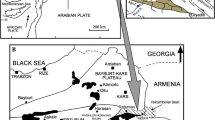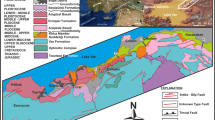Abstract
The upper Miocene non-marine sediments of the Çankiri-Çorum basin in central Anatolia, have both evaporitic and non-evaporitic successions. These sediments were deposited in an evaporitic lake which had temporary episodes of palustrine conditions in response to seasonal or climatic changes. The successions show different facies such as sulfates, carbonates and siliciclastics. The sulfates comprise primary, reworked and diagenetic gypsum. The primary deposits are predominantly laminated gypsum, bedded gypsum and selenite. The reworked (detrital) gypsum comprises gypsite, gypsarenite, gypsrudite and breccias. The diagenetic type comprises micro- and macrogypsum nodules. The carbonates mainly include clayey limestone, oolitic limestone and dolomite. The siliciclastics comprise red beds and both channel and non-channel, conglomerates and mudstones.
Laminated gypsum, composed of alternating gypsum and dolomite, was a result of environmental schizohalinity. Bedded gypsum was precipitated in the deeper part of the lake during high evaporation periods. Chevron-type selenite crystals formed on saline mud flats during the times of aridity, whereas the discoidal-type seen in the organic-rich mudstones occurred in the gypsiferous marshes during the times of humidity. Reworked (detrital) gypsum dominates the lake margin. These formed during periodic wet episodes that caused reworking of primary gypsum. Gypsum nodules occurred as both early and late diagenetic products. Carbonates and siliciclastics were deposited during the freshening periods of the lake.
Climatic or seasonal changes were the main causes of the depositional styles of the upper Miocene evaporitic and non-evaporitic lacustrine deposits in Çankiri-Çorum basin. Additionally, the transition upward from alluvial to lake environment implies an important change in drainage patterns that likely occurred as a result of marginal fault activity.
Similar content being viewed by others
References
AIGNER, T. and BACHMAN, G.H., 1989, Dynamic stratigraphy of an evaporitic-to-redbed sequence, Gipskeuper (Triassic), southwest German Basin:Sedimentary Geology, v. 62, p. 5–25.
BELLANCE, A., KARAKAS, Z., NERI, R., and VAROL, B., 1993, Sedimentology and isotope geochemistry of lacustrine dolomite-evaporite deposits and associated clay (Neogene, Turkey), environmental implication:Miner. Petrogr. Acta, v. 36, p. 245–264.
BIRGILI, S., YOLDAS, R. and UNALAN, G., 1975, Çankiri-Çorum havzasinin jeolojisi ve petrol olanaklari:MTA Raporu, no. 5621.
BRUJIN, H. DE, DAM, J., DAXNER-HÖCK, G., FAHLBUSCH, V., and STORCH, G., 1996, The Genera of the Murinae, endemic insular forms excepted, of Europe and Anatolia during the Late Miocene and Early Pliocene.In Bernor, R.L. et al., eds., The Evolution of Western Eurasian Neogene Mammal Faunas, Columbia University Press, p. 253–260.
CODY, R.D., 1976, Growth and early diagenetic changes in artificial gypsum crystals grown within bentonite muds and gels:Geological Society of America Bulletin, v. 87, p. 1163–1168.
CODY, R.D., 1979, Lenticular gypsum: occurrences in nature and experimental determinations of effects of soluble green plant material on its formation:Journal of Sedimentary Petrology, v. 49, p. 1015–1028.
EL-TABAKH, M., RICCONI, R., and SCHREIBER, B.C., 1997, Evolution of late Triassic rift basin evaporites (Passaic Formation), Newark Basin, Eastern North America:Sedimentology, v. 44, p. 767–790.
ERDOGAN, B., AKAY, E., and Ugur, M.S., 1996, Geology of the Yozgat region and evolution of the collisional Çankiri Basin:International Geology Review, v. 38, p. 788–806.
HARDIE, L.A. and EUGSTER, H.P., 1971, The depositional environment of marine evaporites. A case for shallow, clastic accumulation:Sedimentology, v. 16, p. 187–220.
HARDIE, L.A., SMOOT, J.P., and EUGSTER, H.P., 1978, Saline lakes and their deposits.In A. Matter and M.E. Tucker, eds., Modern and Ancient Lake Sediments. Special Publications of the International Association of Sedimentologists, v. 2, p. 7–41.
HELVACI, C. and ORTI, F., 1998, Sedimentology and diagenesis of Miocene colemanite-ulexite deposits (western Anatolia, Turkey):Journal of Sedimentary Petrology, v. 68, p. 1021–1033.
KINSMAN, D.J.J., 1969, Modes of formation, sedimentary associations and diagnostic features of shallow-water and supratidal evaporites:American Association of Petroleum Geologists Bulletin, v. 53, no. 4, p. 830–840.
LOGAN, B.W., 1987, The Macleod Evaporite Basin, Western Australia: American Association of Petroleum Geologists Memoir, v. 44, 140 p.
MEGIAS, A.G., ORDONEZ, S., CALVO, J.P., and GARCIA DEL CURA, M.A., 1982, Sedimentos de flujo gravitacional yesifores y facies asociadas en la Cuenca Neogene de Madrid, Espana:Buenos Aires, Actas V Congreso Latinoamericano de Geologia, v. 2, p. 311–328.
MAGEE, J.W., 1991, Late Quaternary, groundwater, eolian and pedogenic gypsum in the Prungle Lakes, Southeastern Australia:Paleogeography, Palaeoclimatology, Palaeoecology, v. 84, p. 3–42.
MANDADO, J. and TENA, J.M., 1985, A peel technique for sulfate and carbonate rocks:Research Methods Papers, p. 548–549.
MURRAY, R.C., 1964, Origin and diagenesis of gypsum and anhydrite:Journal of Sedimentary Petrology, v. 34, no. 3, p. 512–523.
NURY, D. and SCHREIBER, B.C., 1997, Paleogene basins of southern Provence.In: G. Busson and B.C. Schreiber, eds., Sedimentary Deposition in Rift and Foreland Basins in France and Spain (Paleogene and Lower Neogene), New York, Columbia University Press, p. 240–300.
ORTI, F. and ROSELL, L., 2000, Evaporite systems and diagenetic patterns in the Calatayud basin (Miocene, central Spain):Sedimentology, v. 47, p. 665–685.
ROUCHY, J.M., 1982, La Genèse des évaporites Messiniennes de Méditerrane: Paris, Mémoire de Museum National d’Histoire Naturelle, Ser. C, tom. L., 306 p.
ROUCHY, J.M., BERNET-ROLLANDE, M.C., and MAURIN, A.F., 1986, Pétrographie descriptive des évaporites. Applications sur le terrain, en subsurface et au laboratoire.In Les Séries a Évaporites en Exploration Pétrolifère, 1—Methodes Géologiques. Paris, Editions Technip, p. 73–122.
SALVANY, J.M., MUNOZ, A., and PEREZ, A., 1994, Nonmarine evaporitic sedimentation and associated diagenetic processes of the southwestern of the Ebro basin (Lower Miocene, Spain):Journal of Sedimentary Petrology, v. 64, p. 190–203.
SANZ, M.E., RODRIGUEZ-ARANDA, J.P., CALVO, J.P., and ORDONEZ, S., 1994, Tertiary detrital gypsum in the Madrid, Basin, Spain: Criteria for interpreting detrital gypsum in continental evaporitic sequences.In Sedimentology and Geochemistry of Modern and Ancient Saline:SEPM Special Publication, no. 50, p. 217–228.
SCHREIBER, B.C., 1978, Environments of subaqueous gypsum deposition.In W. Dean and B.C. Schreiber, eds, Marine Evaporites, SEPM Short Course Notes, v.4, p. 43–73.
SHEARMAN, D.J., 1966, Origin of marine evaporites by diagenesis:Transactions of the Institute of Mining and Metallurgy, v. B75, p. 207–215.
SEN, S., SEYITOGLU, G., KARADENIZLI, L., KAZANCI, N. VAROL, B., and ARAZ, A.H., 1998, Mammalian biochronology of Neogene deposits and its correlation with the litostratigraphy in the Çankiri-Çorum basin, central Anatolia, Turkey:Eclogae Geologicae Helvetiae, v. 91, p. 307–320.
TRUC, G., 1980, Evaporites in a subsident continental basin (Ludian and Stampian of Mormorion-Pernes in southeastern France): Sequential aspects of deposition primary facies and their diagenetic evolution.In Evaporite Deposits. Paris, Editions Technip, p. 61–71, 234–259.
TÜRKMEN, I. and ÖZKUL, M., 1999, Sedimentology and evaporite genesis of Neogene continental sabkha playa complex, Karakecili Basin, central Anatolia, Turkey:Carbonates and Evaporites, v. 14, no. 1, p. 21–31.
WARREN, J.W., 1982, The hydrological setting, occurrence and significance of gypsum in Late Quaternary salt lakes in south Australia:Sedimentology, v. 29, p. 609–637.
YAGMURLU, F. and HELVACI, C., 1994, Sedimentological characteristics and facies of the evaporite-bearing Kirmir formation (Neogene), Beypazari Basin, central Anatolia, Turkey:Sedimentology, v. 41, p. 847–860.
Author information
Authors and Affiliations
Corresponding author
Rights and permissions
About this article
Cite this article
Varol, B., Araz, H., Karadenizli, L. et al. Sedimentology of the Miocene evaporitic succession in the north of Çankiri-Çorum basin, central Anatolia, Turkey. Carbonates Evaporites 17, 197–209 (2002). https://doi.org/10.1007/BF03176485
Published:
Issue Date:
DOI: https://doi.org/10.1007/BF03176485




